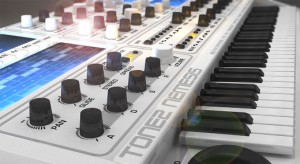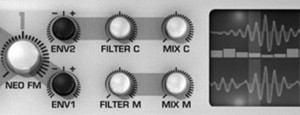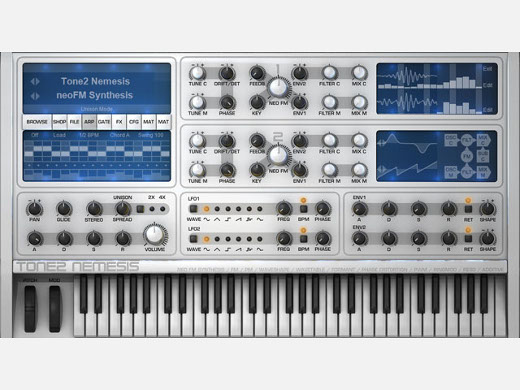Review: Nemesis NeoFM Synthesis Virtual Instrument, from Tone2
Few developers can consistently pump out quality product after quality product, but Tone2 seems to be making this a regular habit. The synth developer is constantly carving their own path within synth lore with their new takes on the approach to sound generation.
Even with their simple subtractive freeware synth, FireBird 2, Tone2 manages to produce a quality instrument by injecting their personal style within its architecture. Whether the synth is based purely on inspiration or an exclusive concept held by Tone2, this is a company that produces quality virtual instruments.
Earlier this year I had the pleasure of reviewing their previous release, Rayblaster, which you can see here. This synth itself introduced a new synthesis concept that Tone2 calls Impulse Modeling Synthesis (IMS), producing unique sonic characteristics that add a new level of signature to any sound designer/musicians repertoire.
Now with the release of Nemesis, Tone2 expands their unique line with what they call the next evolutionary step in FM synthesis, NeoFM synthesis. So why bother taking FM synthesis to the next step?
The Problem
Tone2 made sure to take just as much care in designing Nemesis as they did with Rayblaster.
Nemesis takes the best aspects of both types of FM synthesis (phase modulation and “real analog FM”) and combines them, booting out the negative effects of conventional FM methods.
The main issues with phase modulation is that users have a limited variety of waveforms they can use to effectively produce sounds that do not contain harsh elements and just sound good. The problem with “real analog FM” is that, without digital precision and control, sounds can suffer from drift resulting in sounds that may not fit musically and sound out of place.
The Solution
With NeoFM, users can take advantage of a much larger variety of waveforms rather than typical sine and triangle wave forms while faithfully producing FM synthesis. NeoFM is accomplished by having a Carrier oscillator and a Modulator oscillator.
In this case, the Modulator waveform is used to control the frequency of the Carrier waveform, resulting in simple to very complex sounds. Add a ton of other combinable synthesis types and these few features alone add a whole other dimension of flexibility to Nemesis.
Spoiler Alert: Tone2 has includes a unique ‘Advanced Formant Synthesis’ style that is unique to Nemesis. While formant filtering is nothing new, this tweaked synthesis type offers a layer of sophistication to formant sounds that, while being tricky to grasp, can create some fun sounds.
Tone2 has also taken the liberty of adding additional controls like drift control, optimized filters to negate phase shift, ‘RET’ to enable different re-trigger modes and more to help keep the sound expressive and tight.
The extremely expanded sonic possibilities that Nemesis is capable of makes it difficult to describe what exactly this synth sounds like, because while it can achieve traditional FM synthesis, it can also produce so much more beyond that. I can however say that of the 1000 presets I actually did play around with, all of them sounded FANTASTIC.
Your Synth’s New Nemesis
Now that I have the basic explanation displayed for your viewing pleasure, let’s get down to how Nemesis sounds. I’ll start off by beginning a slow clap for Tone2 because they have absolutely produced another amazing soft synth. When they say it’s best to hear for yourself they mean it.
Right off the bat, the synth demonstrates its fit with modern music and sound design with their “Welcome” preset. If this doesn’t inspire more exploration then you might need to show yourself to the door. Because you have failed the love of sound:
As demoed above, the re-synthesis capabilities add yet another dimension of possibilities within Nemesis and even includes dozens of different waveforms to sample. Not only that but Nemesis also offers a total of 22 combinable synthesis variations from wavetable to ring modulation.
Features:
The heart of Nemesis lies in the core routing design and the ability to combine a variety of synthesis types that can produce amazing clarity of sound, but the soul lies in just how well the internal features complement these sounds. These range from a stereo Gate, modulation routing, internal FX, the arpeggiator, and the deep Additive Spectral Editor (another favorite!).
The reason I love the presets in Nemesis is because they are all fully developed sounds, and they span every feature that is available, thus 1000 presets! Hit the key once and users will realize just what this synth is capable of. Here are a few of my favorites:
What’s Missing?
Nemesis is by far one of the best FM synths currently available. It really is difficult to ask for more from such a cornucopia of musical offerings. While there is no shortage of material to choose from, I think users should look forward to more available waveforms in the future and maybe even more synthesis types.
Until that day, I think synth enthusiasts will find themselves busy for months just experimenting on their own and modifying existing presets.
Conclusion
Nemesis is second to none in the realm of FM synthesis. The learning curve makes it extremely easy to navigate while the amount of content will have users of all skill levels coming back for more. Like the game of chess, Nemesis is easy to learn but will take time to master.
At the price of $199.99, with additional sound sets already available for purchase, Nemesis is a must buy for anyone looking to add a completely new instrument to their arsenal that they will use for years. In my professional opinion, Nemesis truly lives up to the “next evolutionary step” in FM synthesis.
— Gabe Lamorie
Please note: When you buy products through links on this page, we may earn an affiliate commission.









